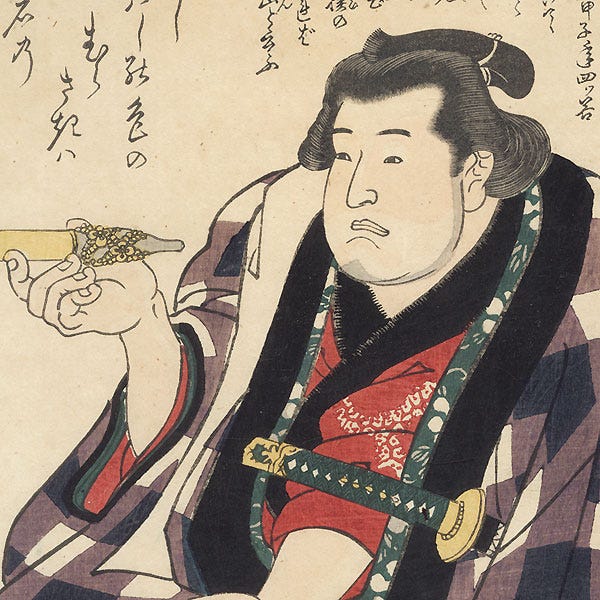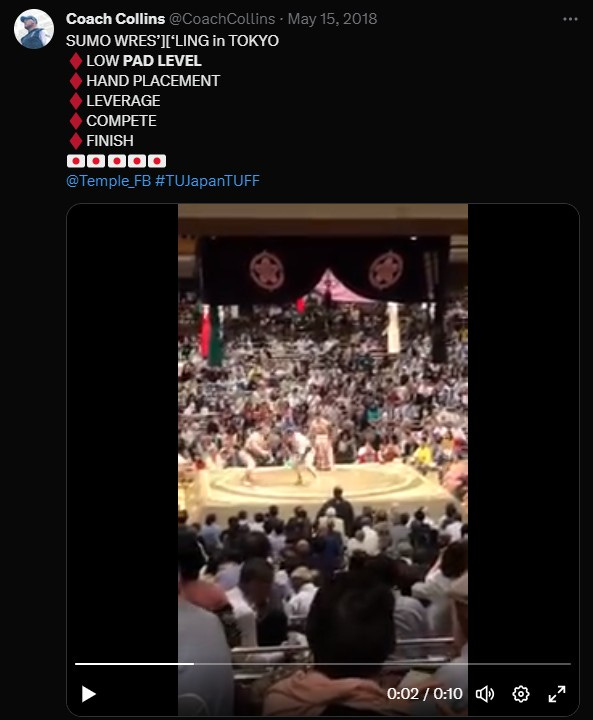Colorado State Sumo-Turned-Defensive Lineman Hidetora Hanada and Change vs. Tradition
Regardless if he plays a down, no newcomer to college football this season intrigues me more than Colorado State defensive lineman Hidetora Hanada.
Hanada’s story is of general interest, to be sure: The Associated Press just last week featured the new addition to the Rams defensive front. AP focused on his quick transition from sumo wrestling to Div. I American college football, which included a quote from Colorado State defensive line coach Buddha Williams praising Hanada’s “unbelievable pad level.”
I chuckled a bit; “pad level” seems to be a recurring theme — albeit with a limited sample size — as far as American football coaches evaluating sumo.
In the vein of former Temple and Georgia Tech head coach Geoff Collins’ above tweet, there’s a perhaps tongue-in-cheek sentiment going back years about sumo translating to the gridiron. It’s a half-serious, half-joking idea not unlike suggestions back around 2008 that world record-setting sprinter Usain Bolt could become a dominant wide receiver just by virtue of his speed and height.
The first such instance of sumo wrestling being fantasy booked for football that I ever encountered was in a magazine article I read my freshman year of college. The piece focuses on Hawaiian-born Chad Rowan, known as Akebono Taro in an illustrious sumo career during which he became the first foreigner to achieve the rank of yokozuna.
A tradition that began with the possibly mythical Akashi Shiganosuke in the 1600s, there have been only 73 yokozuna ever; Akebono was the 64th.

An important distinction with regard to Colorado State’s Hidetora Hanada is that his classification was as an amateur yokozuna; impressive, to be sure, but not the champion-of-champions honor Chad Rowan earned in a landmark career that ended in 2001.
It wasn’t long after Akebono retired that I read the aforementioned article about his career. The multiple-page feature posited, among other things, that the 6-foot-8, 500-pounder could leverage his size and dominance in the dohyō to an NFL offensive line.
That didn’t come to pass, of course, as Akebono instead embarked on a brief professional wrestling career. But in Hidetora Hanada’s remarkable journey to Fort Collins, the potential of an idea planted in my head decades ago is nearing fruition.
And that I can’t more explicitly share the origin of that idea drives me nuts.
See, the Akebono feature — which was also a more broad look at the sport of sumo for an American audience — appeared in one of those general-interest men’s magazines that were ubiquitous in the early 2000s.
For those too young to have experienced it, or as a refresher for those who don’t remember, newsstands were littered with publications like Maxim, FHM and Stuff that were ostensibly the same. Each featured a scantily clad cover model, usually an actor or musician with an upcoming projection promoted alongside racy — but not “covered by cellophane on the shelf” racy — photography.

The pictorials were a PG-13 alternative to the more R-rated calling card of Playboy. Likewise, the articles in these magazines were usually much less adult or complex than the in-depth reporting and thought-provoking essays that ran in Playboy.
Yes, I really was someone who read Playboy for the articles. And I miss the days of thumbing through a hard-copy publication that was guaranteed every four weeks to offer up insights on at least one topic I might not seek out for myself.
Whichever of those PG-13 Playboy knockoffs that showcased the traditions and history of sumo in between style tips from a Von Dutch-wearing sleaze and a fluffy cover story on American Pie 2 or Nelly Furtado’s debut album or whatever is a prime example.
I have long credited reading my dad’s Sports Illustrated copies for first getting me interested in sports journalism. However, that sumo article I happened upon while killing time in the dorm and idly flipping through my friend’s magazine provided a freshman Journalism me with an example of the kind of sports writing I one day hoped to pursue.
The internet killed magazines — a decline that really began in earnest the year I graduated, excellent timing for an aspiring magazine writer — and along with it died that likelihood of stumbling into a topic you might not otherwise encounter.
Worse yet, despite the seemingly boundlessness of online media, so much content produced the last two decades; the last decade; hell, in the last five years has just disappeared into the ether. Erasing physical media isn’t so easy as taking servers offline.
I’ve spent years looking for that sumo wrestling article both to revisit a piece of media that profoundly inspired me as a teen, and to share with others, to no avail. It sometimes feel like a dream.
I think of this in the context of college football, a sport built on tradition undergone seismic changes in recent years. Change has always impacted the college football landscape, though certainly not at the scale nor as quickly at any time in my years following it as now.
Progress and change are often positive. While I miss the high-minded journalism that appeared in Playboy, the magazine and the raft of imitators it spawned were the quintessential mirror of a society that commodified sex and assigned value to women based on physical appearance.
Likewise, changes in college football can be positive. The game’s growth internationally that brings an athlete like Hidetora Hanada to Colorado State is one such positive.
TV networks influencing change that could possibly kill a conference with more than a century of history isn’t positive, nor is the general erosion of the the traditions that make the sport unique. And the path I believe we’re headed down is one akin to the internet killing print publishing, ultimately narrowing our perspective instead of expanding it.
Striking the right balance in embracing progress while protecting traditions brings me back to the world from which Hidetora Hanada comes; the 1,500-year-old sport of sumo.
This summer, I watched the first season of the Netflix series Sanctuary.The show can be best described as part Friday Night Lights, part Cobra Kai and blended together in the world of sumo.
The program’s worth checking out if for no other reason than it having one of the hardest opening-credit sequences on television.
While Sanctuary takes artistic license with certain realities of sumo, one of its main themes — the persistent struggle between change and tradition — resonates.
There’s plenty about the college football world that’s changing to the detriment of tradition. A more global game that has a place for an athlete of Hidetora Hanada’s caliber is one change I welcome.




